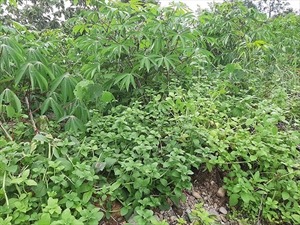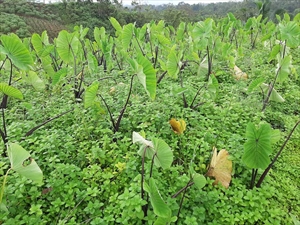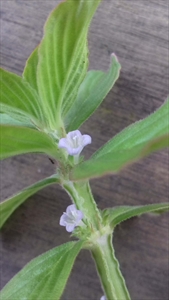- Worldwide distribution. In Australia, Fiji, French Polynesia, Samoa.
- Aggressive, invasive weed of annual crops (maize, soybean, rice), plantations (sugarcane, rubber, tea), orchards, riverbanks, roadsides. A weed of cassava and taro in Pacific islands.
- Stems, erect or spreading, up to 1m, square, narrowly 'winged', woody at base, sometimes rooting. Leaves, broad, hairy, oval, leaf stalks absent or short; stipules with bristles. Flowers, in leaf axils and terminal, white, blue or mauve petals fused to form 5mm long tube. Fruit covered in white hairs. Seeds smooth with cavity. Long flowering time.
- Spread: seed contaminant of grain, livestock feed, plant nursery materials.
- Biosecurity: regulate imports of seeds, feeds and plant introductions.
- Biocontrol: none.
- Cultural control: hand-weed; cultivate to reduce surface seed germination.
- Chemical control: (soybean) - glyphosate + 2,4-D; glyphosate + 2,4-D + diclosulam, followed by glufosinate; imazethapyr. (oil palm and rubber) - glyphosate + picloram; glyphosphate + terbuthylazine; glufosinate, metsulfuron; (maize) - terbuthylazine.
Pacific Pests, Pathogens and Weeds - Online edition
Pacific Pests, Pathogens, Weeds & Pesticides
Winged false buttonweed (491)
Winged false buttonweed. It is also known as the broad-leafed buttonweed, broadleaf buttonweed. Note, this name is also given to Spermacocoe alata, e.g., by USDA Natural Resources Conservation Service.
Spermacoce latifolia; previously, it was known as Borreria latifolia. Note, The Royal Botanic Gardens Kew lists this species separately from Spermococe alata. According to RBG, Spermococe latifolia has spread widely from South and Central America, including to the Pacific, whereas Spermococe alata is a weed of South America alone. Some online websites suggest these two species are the same. It is a member of the Rubiaceae.
AUTHOR Grahame Jackson
Information from Spermacoce latifolia Aubl. (2020) Australian Tropical Rainforest Plants. (https://apps.lucidcentral.org/rainforest/text/entities/spermacoce_latifolia.htm), and Spermacoce alata. Plants of the World online. Kewscience. (http://www.plantsoftheworldonline.org/taxon/urn:lsid:ipni.org:names:766585-1); and Spermacoce latifolia Aubl. Plants of the world online. Royal Botanic Gardens, Kew. (http://www.plantsoftheworldonline.org/taxon/urn:lsid:ipni.org:names:766800-1); and Wiersema JH, et al. (2017). A new weed in Florida, Spermacoce latifolia and the distinction between S. alata and S. latifolia (Spermacoceae, Rubiaceae) Castanea 82: 114-131; and Spermacoce latifolia (2013) Pacific Island Ecosystems at Risk (PIER) (http://www.hear.org/pier/species/spermacoce_latifolia.htm); and CABI (2019) Borreria latifolia (broadleaf buttonweed). Invasive Species Compendium. (https://www.cabi.org/isc/datasheet/9478); and from Macanawai AR (2016) Spermacoce latifolia - a predominant alien invasive plant in root crops and its management in Loaivuna, Viti Levu, Fiji. Acta Hortic. 1123, 215-220. (DOI: 10.17660/ActaHortic.2016.1123.30). Photos 1,4&6 Joel E Miles Ph.D. PO Box 1543, Republic of Palau 96940. Photos 2,3&5 Apaitia R Macanawai, P.O Box 18462, Suva, Fiji. Photo 7 USDA APHIS PPQ, Bugwood.org.jpg.
Produced with support from the Australian Centre for International Agricultural Research under project HORT/2016/185: Responding to emerging pest and disease threats to horticulture in the Pacific islands, implemented by the University of Queensland and the Secretariat of the Pacific Community.










